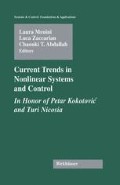Summary
In this chapter, we present two main contributions: (1) a leader-follower formation controller based on dynamic feedback linearization, and (2) a framework for coordinating teams of mobile robots (i.e., swarms). We derive coordination algorithms that allow robot swarms having independent goals but sharing a common environment to reach their target destinations. Derived from simple potential fields and the hierarchical composition of potential fields, our framework leads to a decentralized approach to coordinate complex group interactions. Because the framework is decentralized, it can potentially scale to teams of tens and hundreds of robots. Simulation results verify the scalability and feasibility of the proposed coordination scheme.
The work of the first author is partially supported by NSF grants #0311460 and #0348637 (CAREER), and by the U.S. Army Research Office under grant DAAD19-03-1-0142 (through the University of Oklahoma).
Access this chapter
Tax calculation will be finalised at checkout
Purchases are for personal use only
Preview
Unable to display preview. Download preview PDF.
References
Baras JS, Tan X, Hovareshti P (2003) Decentralized control of autonomous vehicles 1532–1537. In: Proc. IEEE Conf. on Decision and Control, Maui, HI
Barraquand J, Latombe J (1993) Non-holonomic multibody mobile robots: controllability and motion planning in the presence of obstacles. Algorithmica 10:121–155
Belta C, Kumar V (2004) Abstraction and control for groups of robots. IEEE Trans. on Robotics and Automation 20(5):865–875
Bemporad A, De Luca A, Oriolo G (1996) Local incremental planning for a car-like robot navigating among obstacles 1205–1211, In: Proc. IEEE Int. Conf. on Robotics and Automation, Minneapolis, MN
Butenko S, Murphey R, Pardalos P (eds) (2003) Cooperative control: models, applications and algorithms, vol. 1 of Applied optimization. Kluwer Academic Publishers, Dordrecht
Chaimowicz L, Kumar V, Campos M (2004) A paradigm for dynamic coordination of multiple robots. Autonomous Robots 17(1):7–21
Das AK, Fierro R, Kumar V, Ostrowski JP, Spletzer J, Taylor CJ (2002) A vision-based formation control framework. IEEE Trans. on Robotics and Automation 18(5):813–825
De Luca A, Oriolo G, Samson C (1998) Feedback control of a nonholonomic car-like robot In: Laumond J.-P (ed), Robot motion planning and control, 171–253. Springer-Verlag, London
Fierro R, Clark J, Hougen D, Commuri S (2005) A multi-robot testbed for bilogically inspired cooperative control In: Schultz A, Parker L, Schneider F (eds), Multi-robot systems: from swarms to intelligent automata, Naval Research Laboratory, Washington, DC
Fierro R, Lewis FL (1997) Control of a nonholonomic mobile robot: backstepping kinematics into dynamics. J. Robotic Systems 14(3):149–163
Fierro R, Song P, Das AK, Kumar V (2002) Cooperative control of robot formations In: Murphey R, Pardalos P (eds), Cooperative control and optimization, vol. 66 of Applied optimization, chapter 5, 73–93. Kluwer Academic Publishers, Dordrecht
Gerkey BP, Matarić MJ (2004) A formal analysis and taxonomy of task allocation in multi-robot systems. Int. J. Robot. Research 23(9):939–954
Ghosh R, Tomlin C (2000) Maneuver design for multiple aircraft conflict resolution 672–676. In: Proc. American Control Conference, Chicago, IL
Isidori A (1995) Nonlinear control systems, Springer-Verlag, London
Khatib O (1986) Real-time obstacle avoidance for manipulators and mobile robots. International Journal of Robotics Research 5:90–98
Koditschek D (1987) Exact robot navigation by means of potential functions: some topological considerations 1–6. In: Proc. IEEE Int. Conf. Robot. Automat.
Kumar V, Leonard N, Morse A (eds) (2004) A post-workshop volume, 2003 Block Island Workshop on Cooperative Control Series, vol. 309 of LNCIS. Springer-Verlag, London
LaValle S, Hutchinson S (1998) Optimal motion planning for multiple robots having independent goals. IEEE Trans. on Robotics and Automation 14(6):912–925
Leonard NE, Fiorelli E (2001) Virtual leaders, artificial potentials and coordinated control of groups 2968–2973. In: Proc. IEEE Conf. on Decision and Control, Orlando, FL
Ögren P, Fiorelli E, Leonard N (2004) Cooperative control of mobile sensor networks: adaptive gradient climbing in a distributed environment. IEEE Trans. on Automatic Control 49(8):1292–1302
Okubo A (1985) Dynamical aspects of animal grouping: swarms, schools, flocks and herds. Advances in Biophysics 22:1–94
Oriolo G, De Luca A, Vendittelli M (2002) WMR control via dynamic feedback linearization. IEEE Trans. on Robotics and Automation 10(6):835–852
Song P, Kraus P, Kumar V, Dupont P (2001) Analysis of rigid-body dynamic models for simulation of systems with frictional contacts. ASME Journal of Applied Mechanics 68:118–128
Song P, Kumar V (2002) A potential field based approach to multi-robot manipulation 1217–1222. In: Proc. IEEE Int. Conf. Robot. Automat., Washington, DC
Spletzer J, Das A, Fierro R, Taylor CJ, Kumar V, Ostrowski JP (2001) Cooperative localization and control for multi-robot manipulation 631–636. In: IEEE/RSJ Int. Conf. on Intelligent Robots and Systems, Maui, HI
Author information
Authors and Affiliations
Editor information
Editors and Affiliations
Rights and permissions
Copyright information
© 2006 Birkhäuser Boston
About this chapter
Cite this chapter
Fierro, R., Song, P. (2006). Coordination of Robot Teams: A Decentralized Approach. In: Menini, L., Zaccarian, L., Abdallah, C.T. (eds) Current Trends in Nonlinear Systems and Control. Systems and Control: Foundations & Applications. Birkhäuser Boston. https://doi.org/10.1007/0-8176-4470-9_19
Download citation
DOI: https://doi.org/10.1007/0-8176-4470-9_19
Publisher Name: Birkhäuser Boston
Print ISBN: 978-0-8176-4383-6
Online ISBN: 978-0-8176-4470-3
eBook Packages: Mathematics and StatisticsMathematics and Statistics (R0)

